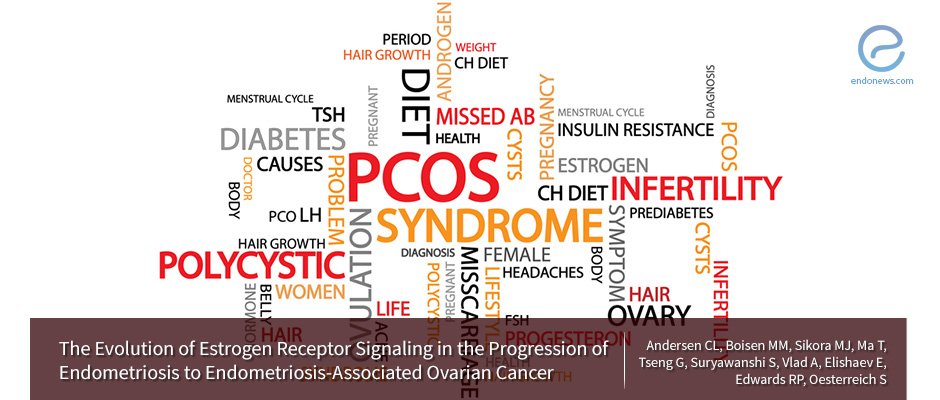Estrogen Receptor Signaling and Endometriosis-Associated Ovarian Cancer
Mar 21, 2019
The gene expression pattern in EAOC is more consistent with endocrine resistance
Key Points
Highlights:
- During the progression of endometriosis to Endometriosis-Associated Ovarian Cancer (EOAC), estrogen receptor-α expression and classical signaling decreases. In fact, several ERα-induced genes such as NRIP1 remain highly expressed and de-repression of target genes such as FGF18 seem to contribute to the estrogen-dependent progression, resulting in endocrine resistance.
Importance
- Given the shared pathway of endometriosis and ovarian cancer as estrogen-responsive disease entities, the investigation of how ERα signaling evolves during progression from endometriosis to endometriosis-associated ovarian cancer is important.
Background:
- Estrogen has been implicated in endometriosis-associated ovarian cancer, like clear cell cancer (CCC), endometrioid ovarian cancer (ENOC), and low-grade serous cancer (LGS).
- Estrogen receptors ESR1 (E2α) and ESR2 (E2β) can be found in the nucleus, cytoplasm and the membrane of the cell. When the estrogen molecules bind these receptors (especially E2α) gene expression begins. This gene signature of estrogen response is called estrogen signaling.
- E2 signaling panel is composed of 236 genes associated with the endocrine response to estrogen., out of which 207 isolated from breast, ovarian, endometrial and bone cancer. Remaining genes target ovarian cancer more specifically (eg: NCOA1, GATA3, FOXA1)
What's done here:
- Tissue samples from patients with endometriosis, atypical endometriosis, and also both endometriosis and cancer part of the material from patients with EAOCs collected and compared to healthy patient normal endometrium tissues to evaluate the changes in estrogen signaling.
- A comprehensive gene signature of estrogen response was used.
Key results:
- The gene expression changes associated with each disease state was examined for understanding the role of ER in the transformation from endometriosis to EAOC.
- Gene expression data suggested that E2 α signaling becomes inactivated throughout the progression of endometriosis to EOAC. Several ERα-induced genes such as NRIP1 remain highly expressed and target genes such as FGF18 de-repressed thus seem to contribute to the estrogen-dependent progression.
Lay Summary
Andersen et al. published a prospective cohort study in the Journal of Hormones and Cancer to enlighten the estrogen signaling pathway during the transition from endometriosis to endometriosis-associated ovarian cancer.
Given the shared pathway of endometriosis and ovarian cancer as estrogen-responsive disease entities, estrogen signaling has been implicated in endometriosis-associated ovarian cancer. To examine the relation and the progression, and to be able to observe its association with estrogen signaling, eighty-three samples collected from the patients with endometriosis, including 11 atypical endometriosis, 9 concurrent endometriosis with cancer, and 21 endometriosis-associated ovarian cancer (EOAC) samples were collected and compared to 23 normal endometrium collected from healthy controls.
Using a comprehensive gene signature of estrogen response (E2 signaling) the authors identified gene expression changes associated with each disease state on 158 differently expressed genes by ANOVA statistical analysis.
The gene expression of estrogen signaling molecules increasingly clustered when changes during the progression from endometriosis to EOAC evaluated.
In endometriosis, estrogen regulation seems to occur through activation of ER β rather than ER α, and this is compatible with their finding that canonical ER α signaling which is largely deactivated in EAOC. The shift from ER α to ER β signaling could be a factor in the transformation from endometriosis to EAOC. ER α and PR levels have been shown to be significantly lower in endometriosis compared to normal epithelium, while ER β was elevated.
The authors concluded that estrogen receptor-α expression and classical signaling decreases during the progression of endometriosis to Endometriosis-Associated Ovarian Cancer. This progression generally occurs through several ERα-induced genes remaining highly expressed such as NRIP1, and de-repression of target genes such as FGF18 to result in endocrine resistance.
Research Source: https://www.ncbi.nlm.nih.gov/pubmed/30302736
gene expression endometriosis-assossiated ovarian cancer clear cell canser low-grade serous cancer E2 ? receptor receptor signaling endometriosis.

